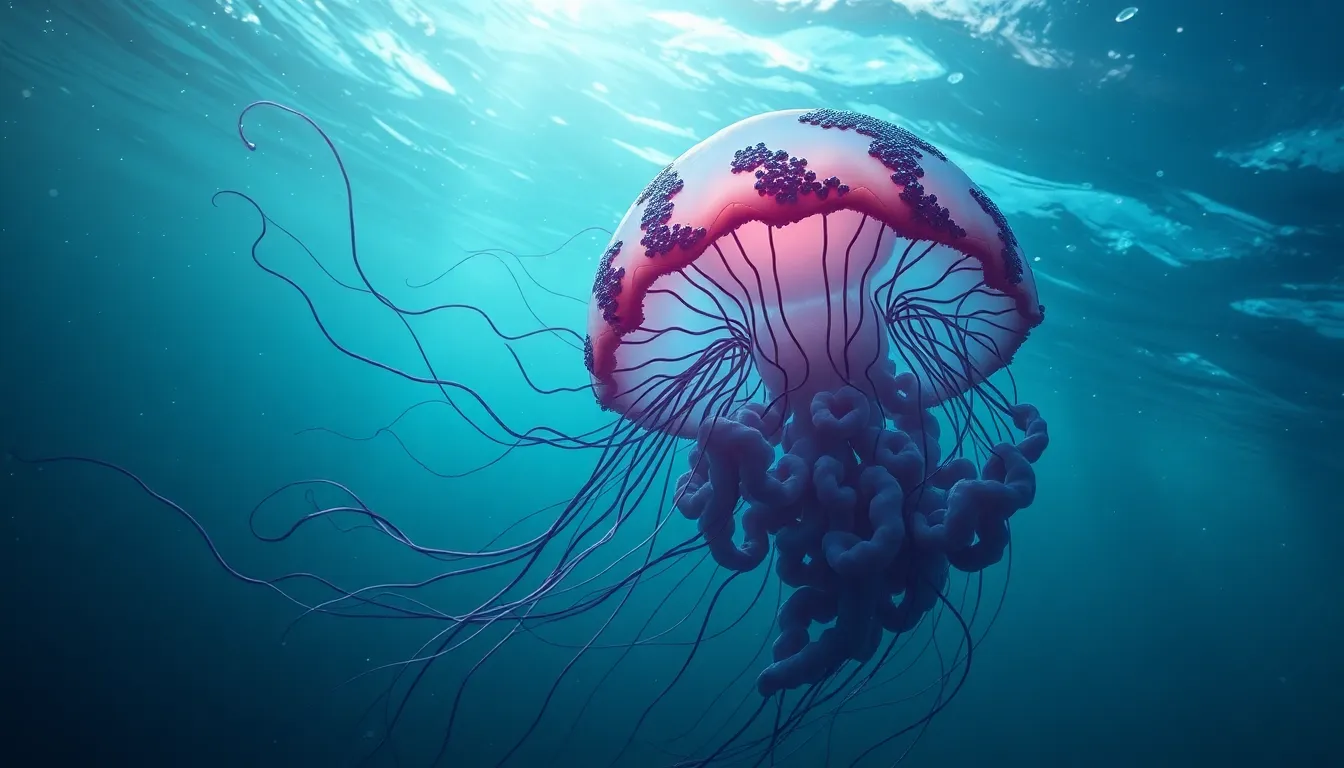The Sacred Jellyfish: Mysteries of the Ocean in Folklore
I. Introduction
Jellyfish are some of the most enigmatic creatures in marine ecosystems, captivating scientists and the public alike with their ethereal beauty and unique biology. These gelatinous organisms, with their delicate, flowing bodies, play crucial roles in oceanic environments, serving as both predator and prey. However, their significance extends beyond the scientific realm, as jellyfish have woven themselves into the folklore and cultural beliefs of societies around the world.
This article aims to explore the intersection of jellyfish, folklore, and cultural beliefs, highlighting how these fascinating creatures have inspired stories, spiritual practices, and artistic expressions throughout history.
II. The Biological Wonders of Jellyfish
A. Anatomy and life cycle of jellyfish
Jellyfish belong to the phylum Cnidaria and possess a simple body plan that includes a gelatinous bell-shaped umbrella and tentacles armed with specialized cells known as cnidocytes. These cells contain nematocysts, which can deliver a sting to capture prey or defend against predators.
The life cycle of jellyfish is complex and includes both a medusa stage and a polyp stage. Jellyfish begin as fertilized eggs that develop into larvae, settle on the ocean floor, and transform into polyps. These polyps can reproduce asexually, producing new jellyfish that eventually detach and grow into mature medusae.
B. Unique characteristics and adaptations
- Bioluminescence: Many jellyfish species can produce light, which they use for signaling and camouflage.
- Regenerative abilities: Jellyfish can regenerate lost body parts, allowing them to survive injuries.
- Adaptations to various environments: Some jellyfish can thrive in both deep and shallow waters, showcasing their versatility.
C. The role of jellyfish in marine biodiversity
Jellyfish are vital components of marine ecosystems. They serve as food for various species, including sea turtles, fish, and even some birds. Additionally, jellyfish contribute to nutrient cycling and can influence the population dynamics of their prey and predators, creating a complex web of interactions in the ocean.
III. Historical Perspectives on Jellyfish in Folklore
A. Ancient civilizations and their interpretations of jellyfish
Throughout history, various civilizations have interpreted jellyfish in diverse ways. Ancient Greeks viewed jellyfish as symbols of the sea’s mystery, while some Native American tribes saw them as important spiritual entities related to the ocean’s balance.
B. Mythological tales involving jellyfish across different cultures
Jellyfish have appeared in numerous mythological tales. In some Pacific Islander cultures, jellyfish are seen as messengers from the sea gods, while in Japanese folklore, they are associated with the spirit world and often depicted as omens.
C. The symbolism of jellyfish in ancient texts and art
In ancient texts, jellyfish often symbolize fluidity and the ephemeral nature of life. Their graceful movement in water has inspired countless artists to portray them in various forms of art, from pottery to paintings.
IV. Jellyfish as Symbols of Spirituality
A. Representations of jellyfish in spiritual practices
Jellyfish have been incorporated into various spiritual practices, often representing transformation and the interconnectedness of life. In some cultures, they are believed to carry messages from ancestors or the spirit world.
B. Jellyfish in modern spiritual movements and beliefs
In contemporary spiritual practices, jellyfish are sometimes viewed as symbols of intuition and emotional depth, encouraging individuals to explore their inner selves and connect with the rhythms of nature.
C. The concept of jellyfish as messengers from the ocean
Many communities believe that jellyfish serve as messengers of the ocean, conveying important lessons about adaptability, resilience, and the beauty of life’s transience.
V. Regional Folklore: Jellyfish in Different Cultures
A. Pacific Islander beliefs and stories about jellyfish
In the Pacific Islands, jellyfish are often associated with creation myths. One story tells of a giant jellyfish that emerged from the ocean to help create the islands, providing sustenance and guidance to the people.
B. The role of jellyfish in Asian folklore and mythology
In Asian cultures, jellyfish frequently appear in tales that emphasize their ethereal beauty and otherworldly qualities. They are seen as symbols of grace and purity, often appearing in traditional art and literature.
C. European interpretations and legends surrounding jellyfish
European folklore often depicts jellyfish as mysterious beings that can foretell the future or provide protection from evil spirits. In some regions, they are associated with the sea witch archetype, possessing both beauty and danger.
VI. Environmental Changes and Folklore
A. The impact of climate change on jellyfish populations
Climate change has significantly affected jellyfish populations, with warmer ocean temperatures and changing currents leading to blooms in some areas. These changes have profound implications for marine ecosystems and local cultures that hold jellyfish in esteem.
B. How changing jellyfish patterns influence local folklore
As jellyfish populations fluctuate, local folklore adapts to reflect these changes. Communities may create new stories based on the abundance or scarcity of jellyfish, incorporating these experiences into their cultural narratives.
C. Folklore as a reflection of human interactions with nature
Folklore serves as a mirror of human interactions with the natural world. As environmental conditions change, so do the stories and beliefs surrounding jellyfish, illustrating the deep connections between people and their ecosystems.
VII. Artistic Representations of the Sacred Jellyfish
A. Jellyfish in literature and poetry
Jellyfish have inspired various literary works and poems, often symbolizing themes of beauty, fragility, and the passage of time. Poets have used their imagery to evoke feelings of wonder and introspection.
B. Visual arts: paintings, sculptures, and installations featuring jellyfish
In the visual arts, jellyfish have captivated artists with their unique forms and movements. Many contemporary artists create installations and sculptures that mimic jellyfish, often emphasizing their ethereal qualities and the importance of marine conservation.
C. The influence of jellyfish on modern pop culture
Jellyfish have made their mark on modern pop culture, appearing in films, music videos, and fashion. Their mesmerizing beauty continues to inspire new generations of creators, making them enduring symbols of oceanic mystery.
VIII. Scientific Exploration of Folklore Themes
A. Investigating the truths behind jellyfish myths
Scientific research has sought to uncover the truths behind various jellyfish myths, revealing their ecological importance and unique adaptations. This exploration helps bridge the gap between folklore and science.
B. How scientific research sheds light on folkloric narratives
Studies on jellyfish behavior and ecology often illuminate the narratives woven into folklore, providing a deeper understanding of how cultures interpret these creatures.
C. The relationship between science and storytelling in understanding jellyfish
Science and storytelling both seek to explain the world around us. By examining jellyfish from both perspectives, we gain a holistic view of their significance in our lives and the environment.
IX. The Future of Jellyfish in Folklore and Conservation
A. The importance of preserving jellyfish habitats
As climate change and human activity threaten marine habitats, preserving the environments where jellyfish thrive is crucial. Conservation efforts are essential to maintain biodiversity and cultural narratives surrounding these creatures.
B. Educating communities about the ecological significance of jellyfish
Educating communities about the ecological roles of jellyfish can help foster a greater appreciation for these creatures. Such awareness can lead to stronger conservation efforts and a deeper understanding of marine ecosystems.
C. The evolving role of jellyfish in contemporary folklore
As human interactions with the ocean change, the role of jellyfish in folklore is also evolving. New stories and beliefs are emerging, reflecting the challenges and triumphs of our relationship with the sea.
X. Conclusion
The sacred jellyfish, with its captivating beauty and ecological significance, continues to inspire awe and wonder across cultures. From ancient myths to modern artistic expressions, jellyfish have carved a unique niche in the collective consciousness of humanity. By exploring their biological wonders, historical perspectives, and spiritual symbolism, we can gain a deeper appreciation for these enigmatic creatures and their role in our world.




